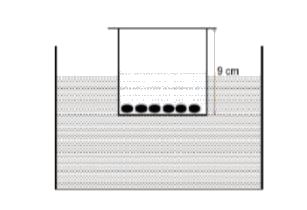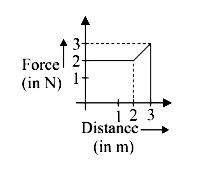The half life of a particle of mass 1.6×10−26kgis6.9 s and a stream of such particles is travelling with the kinetic energy of a particle being 0.05 eV. The fraction of particles which will decay when they travel a distance of 1 m is -
0.1
0.01
0.001
0.0001
The correct Answer is:D
Step by step video, text & image solution for The half life of a particle of mass 1.6xx10^(-26) kg is 6.9 s and a stream of such particles is travelling with the kinetic energy of a particle being 0.05 eV. The fraction of particles which will decay when they travel a distance of 1 m is - by Physics experts to help you in doubts & scoring excellent marks in Class 12 exams.
Updated on:21/07/2023Topper's Solved these Questions
Similar Questions
A wide bottom cylindrical massless plastic container of height 9 cm has 40 identical coins inside it and is floating on water with 3 cm inside the water. If we start putting more of such coins on its lid. It is observed that after N coins are put, its equilibrium changes from stable to unstable. Equilibrium in floating is stable if the geometric center of the submerged portion is above the center of mass of the object) The value of N is closed to

View SolutionA particle of mass m travelling with velocity v and kinetic energy E collides elastically to another particle of mass nm , at rest. What is the fraction of total energy retained by the particle of mass m ?
View SolutionThere is a stream of neutrons with a kinetic energy of 0.0327 eV . If the half-life of neutrons is 700 s , what fraction of neutrons will decay before they travel is distance of 10 m ? Given mass of neutron = 1.676 xx 10^(-27) kg .
View SolutionThere is a stream of neutrons with kinetic energy of 0.0327 eV. If half life of neutrons is 700s, what fraction of neutrons will decay before they travel a distance of 10m? Take mass of neutron = 1.675xx10^(-27)kg.
View SolutionA particle moves in one dimension from rest under the influence of a force that varies with the distance travelled by the particle as shown in the figure. The kinetic energy (in J) of the particle after it has travelled 3 m is ___________

View SolutionThe half life of a stream of radioactive particles moving along a straight path with a constant kinetic energy of 4eV is 1 minute. The percentage of particles which decay before travelling a distance of 3.6 Km is ____.
(Mass of the radioactive particles = 3.2×1021kg and charge of the elecrtron = 1.6×10−19C)
View SolutionA particle is moving in a circle of radius (2)/( 3) m and mass of the particle is 2kg. The kinetic energy of the particle dependes on distance 'S' travelled by the particle as K.E. = 4S^(4) . The angle made by net acceleration with the radial acceleration when the particle rotate by 60^(@) is
View SolutionThe frequency of a cable is 200Hz. When one of the particles on the wire travels half the distance, the velocity of that particle is 4.35 m / s. Determine the acceleration of the particle at that moment.
View Solutionन्यूट्रॉनों की एक धारा की गतिज ऊर्जा 0.0327 eV है यदि न्यूट्रॉनों का अर्ध - आयु समय 700 s हो, तो 10m दूरी तय करने से पहले न्यूट्रॉनों का कितना अंश क्षयित हो जाएगा ?
View SolutionThe distance travelled by a particle is proportional to the squares of time, then the particle travels with
View SolutionA particle of mass m travelling with velocity v and kinetic energy E collides elastically to another particle of mass nm, at rest. What is the fraction of total energy retained by the particle of mass m?
View Solutionएक कण द्वारा तय की गई दूरी समय के वर्ग के समानुपातिक है, तो कण _______ के साथ यात्रा करता है:
View SolutionThe half life of a particle of mass 1.6 xx 10^(-26) kg is 6.9 s and a stream of such particles is travelling with the kinetic energy of a particle being 0.05 eV. The fraction of particles which will decay when they travel a distance of 1 m is
View SolutionA particle of mass 2 kg moving with a speed of 6 m/s collides elastically with another particle of mass 4 kg travelling in same direction with a speed of 2m/s. The maximum possible deflection of the 2 kg particle is
View SolutionA particle is moving in a circle of radius (2)/( 3) m and mass of the particle is 2kg. The kinetic energy of the particle dependes on distance 'S' travelled by the particle as K.E. = 4S^(4) . The angle made by net acceleration with the radial acceleration when the particle rotate by 60^(@) is
View Solution